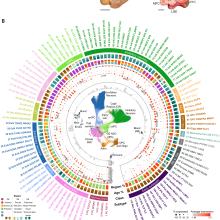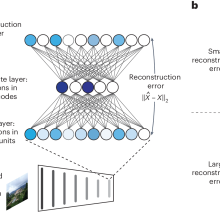Year in Review
Highlights from the past year at the Wu Tsai Institute, spanning July 2023 to June 2024
-
Research
-
Discoveries
-
Humans
-
Building
-
Activities
We stimulated research, launched shared facilities, settled into our new space, and welcomed scientists across career stages. The faculty membership expanded to 180 members drawing from over 30 departments across five schools. The arrival of Kia Nobre, Wu Tsai Professor in the Department of Psychology, as an Associate Director of the Institute and as the Director of the Center for Neurocognition and Behavior fully established the leadership team of the Institute alongside Institute Director Nick Turk-Browne, Associate Directors Daniel Colón-Ramos and John Lafferty, and Managing Director Kelley Remole.
Engage with us as we continue our journey to know, together.

Research
The Institute advances fundamental science to understand human cognition and explore human potential. Its three thematic, interconnected centers — the Center for Neurocomputation and Machine Intelligence, the Center for Neurodevelopment and Plasticity, and the Center for Neurocognition and Behavior — each pursue complementary approaches and support communities of researchers.
Center for Neurocomputation and Machine Intelligence
This Center works to spark the development of new computational frameworks to understand the principles underlying human cognition. Researchers in the Center share expertise in machine learning, artificial intelligence, neuroengineering, hardware design, and more. The Center facilitates their research with high-performance compute and storage clusters, visualization tools, and data-sharing platforms.


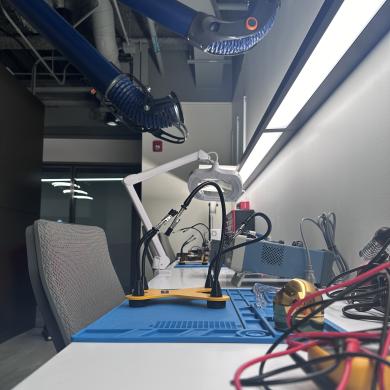
This year, the Center launched the Misha cluster in collaboration with the Yale Center for Research Computing (YCRC). Currently housing some of the most powerful GPU resources at Yale, Misha provides a platform for building and testing large computational models that can capture the richness and complexity of the mind and brain. New web-based access portals and scheduling algorithms support users and facilitate efficient utilization.
The Center launched The Matrix, its shared research facility that contains an experimental server room for testing emerging hardware and software technologies; a visualization lab for in-depth data analysis using large-format displays and immersive VR/XR technologies; and a maker space for prototyping, 3D printing, and hands-on electronics projects. These spaces enable the development of new research platforms for studying and modeling cognition.
As part of its commitment to expand the use of high-performance computing in neuroscience, the Center hosted workshops and training sessions that helped researchers improve their skills and knowledge. The Center also hosted a research workshop, “Abstraction in Minds and Machines,” bringing together students and faculty from several universities.

Center for Neurodevelopment and Plasticity
This Center stimulates research into how the brain develops and evolves, including how it self-organizes and changes with experience. Researchers in the Center share expertise in genetics, molecular and cellular neuroscience, developmental biology, optical imaging, and more. The Center facilitates their research through technological innovations that provide new ways of answering biological questions about the origins of cognition.


This year, the Center completed the physical infrastructure for two microscopy facilities. The Plexus, a research and development facility located in 100 College Street, is dedicated to deploying the latest engineering advances in microscopy and other technologies before they become commercially available. The first installation in The Plexus was a multi-photon microscope for fast neuronal imaging of behaving animals. The second facility, named NeuroLux, will house turn-key instruments that have already been commercialized for studying the molecular and cellular basis of cognition. NeuroLux is connected to the microscopy core of the Department of Neuroscience across a bridge from 100 College Street.
In addition, the Center worked with the YCRC and the research community to build a storage server on Misha for data streams from NeuroLux and The Plexus. This integration with the Center for Neurocomputation and Machine Intelligence will advance the analysis and modeling of data.
The Center also hosted a day-long symposium entitled “Building Blocks of Behavior” for exceptional early-career researchers and held a workshop plus mentorship opportunities on science writing.

Center for Neurocognition and Behavior
This Center studies behavior and brain activity to reveal the organizing principles of human cognition. Researchers in the Center share expertise in cognitive psychology, systems neuroscience, brain-computer interfaces, ecological assessments, and more. The Center facilitates their research through established and emerging tools that provide a window into the inner workings of the brain.



This year, the Center opened BrainWorks, a shared research facility that provides established and emerging technologies for non-invasive measurements of the human brain and behavior. More than 120 researchers received hands-on training on the use of various advanced equipment. Six internal awards supported faculty and trainee investigators to pursue early-stage research projects with this equipment. Presentations on proposed and ongoing projects became a friendly and collaborative forum for researchers to learn about each others’ research. Workshops and external speakers showcased the boundaries of human neuroscience research and methods. BrainWorks was used by four courses in psychology and in neuroscience programs for graduate and undergraduate students.
The Center helped launch the Inspiring Speaker Series, which brought in leading researchers investigating cognition from various perspectives for talks, conversations with researchers, informal gatherings with students and postdocs, and community events. The success of this series led to its expansion into an Institute-wide flagship colloquium.

Discoveries
Collectively, Wu Tsai Faculty Members published 567 journal articles and 100 conference proceedings last year. Here we highlight six of these contributions that are representative of the breadth and significance of research happening in the Institute.
-
BrainLM: A foundation model for brain activity recordings
Read moreWu Tsai Postdoctoral Fellow Josue Caro and Wu Tsai Faculty Member David van Dijk developed a new AI model for neuroscience based on a transformer architecture and thousands of hours of functional magnetic resonance imaging data. The model can predict attributes of people from their brain activity, generalize to new people not used in model training, identify brain networks from raw activity, and reveal the latent structure of cognitive states.
-
Lesions to the mediodorsal thalamus, but not orbitofrontal cortex, enhance volatility beliefs linked to paranoia
Read moreWu Tsai Faculty Members Steve Chang, Phil Corlett, and Jane Taylor used data from monkeys and humans performing the same task, and applied the same computational analysis to both datasets. Their findings offer insights into how paranoia arises in the human brain and establish a cross-species framework to further explore human cognition.
-
Decoding transcriptomic signatures of cysteine string protein alpha-mediated synapse maintenance
Read moreWu Tsai Graduate Fellow Rosa Grijalva with Wu Tsai Faculty Members Hongyu Zhao and Sreeganga Chandra demonstrated that reduced levels of a vesicle chaperone protein might destabilize inhibitory synapses and, unexpectedly, drive neuronal interactions with glia. Revealing changes at the level of individual synapses, these findings deepen our understanding of how connections between cells are maintained and updated.
-
Dissociable codes in motor working memory
Read moreWu Tsai Faculty Member Samuel McDougle revealed that humans can hold complex motor plans in mind and that this ability is distinct from visual forms of working memory. These movements are stored in two ways in memory at the same time, one that is specific to the body part being used and one that is more flexible, providing insight into how humans learn skills.
-
Molecular programs of regional specification and neural stem cell fate progression in macaque telencephalon
Read moreWu Tsai Faculty Members Pasko Rakic and Nenad Sestan collaborated to trace the origins of primate neuronal stem cells earlier in development than previously possible. They followed the pre-natal emergence of cell type and destination, creating a foundational resource for understanding primate brain development and evolution.
-
Images with harder-to-reconstruct visual representations leave stronger memory traces
Read moreWu Tsai Faculty Members Ilker Yildirim and John Lafferty discovered a new principle behind why humans remember some things but not others. Their study combined computational modeling with behavioral experimentation to show that we tend to remember images that require a greater depth of computational processing.
Humans
Welcoming junior faculty
Shreya Saxena, Assistant Professor in the Department of Biomedical Engineering, opened her lab on the 11th floor of 100 College Street. She is a computational neuroscientist who models complex motor and cognitive behaviors with biological constraints. Harry McNamara was recruited as an Assistant Professor in the Department of Molecular, Cellular, and Developmental Biology and will arrive in early 2025. His work uses organoids to study the physics of how the brain self-organizes in development.
Through partnerships with department searches, the Institute welcomed additional assistant professors to Yale: Tristan Geiller and Aaron Kuan in the Department of Neuroscience, Chris Lynn in the Department of Physics, and Tom McCoy in the Department of Linguistics. Tyler Brooke-Wilson was recruited into the Department of Philosophy and the Cognitive Science program.
Along with Cristina Rodriguez, Assistant Professor in the Department of Biomedical Engineering, and Emilia Favuzzi, Assistant Professor in the Department of Neuroscience, these junior faculty make up the initial cohort of Wu Tsai Investigators — new assistant professors from across the University, recruited by or with the support of the Institute, whose research aligns with the Institute’s mission. The program provides a peer group of like-minded colleagues combined with dedicated activities and use of the Institute’s facilities and programs.
Training the next generation
The Institute invests significantly in training the next generation of scientists in the interdisciplinary study of cognition.
Wu Tsai Postdoctoral Fellows are advised by mentors in different departments as they advance interdisciplinary research. Joining this year were Malika Datta, in the labs of Michael Higley and Cristina Rodriguez, and Rahul Singh, in the labs of Joy Hirsch and Smita Krishnaswamy.
Wu Tsai Graduate Fellows are nominated by PhD programs across Yale in a competitive process to find the most promising applicants with interdisciplinary interests that overlap with the Institute’s mission. Four new fellows matriculated this year, growing the program’s representation of a range of doctoral programs, including neuroscience, linguistics, statistics and data science, physics, and psychology.
In total, there are currently 7 Postdoctoral Fellows and 15 Graduate Fellows contributing to the dynamic, boundary-crossing research of the Institute.
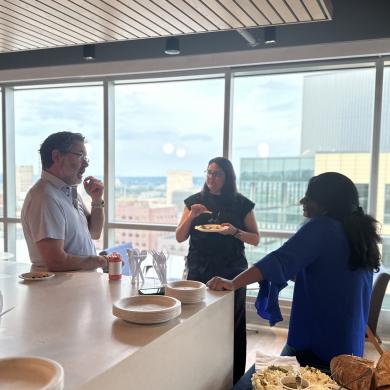


In addition, twelve Wu Tsai Undergraduate Fellows from Yale College conducted research projects in neuroscience, endocrinology, psychology, neurology, and computer science in the Institute’s ten-week summer fellowship program.
All these Fellows benefited from the talented support of the Institute’s new Manager of Student and Postdoctoral Programs, Liz Knapp. She launched professional development workshops and skill building opportunities to help trainees advance interdisciplinary research.


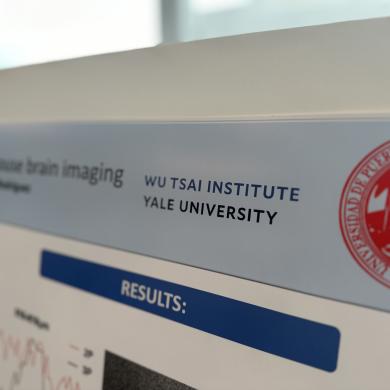
Building
A research hub for brain and cognition
The Institute settled into its new home at 100 College Street in New Haven. Located between the central and medical campuses of Yale, the building convenes and connects scientific communities who have complementary interests. Co-located in the building are the entire Department of Psychology from the Faculty of Arts and Sciences and the Department of Neuroscience from the School of Medicine, along with representatives from several other key departments, including Biomedical Engineering, Comparative Medicine, Computer Science, Genetics, Neurology, Psychiatry, and Statistics and Data Science.

In addition to the shared research facilities described above, the Institute spaces include sun-drenched common areas, co-working spaces, and hoteling offices for the benefit of community members and visitors alike. In just the second half of the year, the Institute hosted over 250 large group gatherings in its Workshop and Classroom spaces for mission-aligned classes, workshops, seminars, and conferences from groups all over campus. Daily coffee hours attracted over 15,000 visitors in the second half of the year to mingle and spark collaborations.



The Institute marked the opening of 100 College Street at a building dedication event in December. The event began with remarks from Provost Scott Strobel, Dean of the Yale School of Medicine Nancy Brown, and Dean of the Faculty of Arts and Sciences Tamar Gendler. They were followed by scientific presentations from Wu Tsai Faculty Members Kia Nobre, Emilia Favuzzi, and Shreya Saxena and a ribbon-cutting ceremony with President Peter Salovey and benefactors Joe Tsai and Clara Wu Tsai. This led to an open-house showcase of the research happening throughout the building in the Institute and the Departments of Psychology and Neuroscience, followed by a celebratory dinner with keynote remarks by Matt Botvinick, Senior Technology and Policy Advisor at Google DeepMind and first-year student at Yale Law School.

We have created a network of scientists and researchers who were previously spread across the university... Now, they are arranged in an integrative entity that links departments and subfields across scales from molecules to mind.
Scott Strobel, Provost and Henry Ford II Professor of Molecular Biophysics and Biochemistry and Professor of Chemistry; Howard Hughes Medical Institute Investigator
Activities
Frequent seminars, symposia, and conferences advanced research and enabled collaborations as faculty, trainees, and staff settled into the Institute’s spaces. We celebrate the programming, partnerships, and artistic pursuits that enliven our home.
Interest Groups
A dedicated group of Yale graduate students and postdocs runs the Institute’s Student and Postdoc Committee (SPC). Co-chairs Sara Sanchez-Alonso and Gustavo Madeira as well as over 15 committee members ran research, professional, and social events for Yale trainees that attracted more than 350 attendees. The group also ran outreach activities for the local community. Their efforts fostered a collaborative and inclusive environment, strengthening connections within the Yale research community while expanding the Institute's reach and impact beyond campus, including partnerships with five organizations.
Trainees and faculty gathered to bridge philosophy and neuroscience as part of the group Applied Philosophy In Neuroscience (APHINE), led by graduate students Alec Sheffield, Clayton Barnes, and Natalia Castelo Branco. Weekly meetings and invited speakers covered topics such as the neuroscience of free will, deep learning in neuroscience, and causation.
The monthly Computational Neuroscience Chalk Talks, run by Wu Tsai Faculty Member Damon Clark, provided a forum for faculty to give and receive feedback on theoretical and computational approaches to questions in neuroscience. Topics included representations of space and time in the hippocampus, neural network models for motor control, and theories of retinal processing. The chalk talks are, by design, full of interruptions and lively discussion.
Scientific Events
The Institute’s annual conference, this year entitled “Grand Challenges in Cognition,” brought together Wu Tsai Faculty Members to identify key scientific challenges on the critical path to understanding human cognition and exploring human potential. The morning session explored the potential of using foundation models from artificial intelligence to integrate neuroscience data across species, tasks, and spatiotemporal scales. The afternoon session focused on how our understanding of behavioral and brain processes can be enriched by studying how humans or animals behave in real-world settings. Identifying challenges related to these areas was the first step in launching the Institute’s new team-science initiative.
Researchers Mohammed Almazrouei, Ohad Dan, Megan Paterson ran a workshop on Artificial Intelligence & Human Decision-Making attracting over 130 registrants from government, industry, and academic sectors. The workshop stimulated dynamic discussion on the complex intersection of AI and human cognition, including perspectives from ethics, economics, social psychology, law, technology, and government.
Art + Science
Artist in residence: Prudence Whittlesey
The Institute’s first artist-in-residence Prudence Whittlesey explored the inner worlds of the Institute community through her project “CounterIntelligence” in which she painted portraits of more than 50 individuals in the Fall semester. These sittings provided a common experience for researchers and a springboard for unexpected conversations and collaborations. Through colloquia, art shows, and her regular presence, Whittlesey created an atmosphere of creative exploration in art as much as science.



Brain and the Barre
Dancers from the Dance Theatre of Harlem collaborated with Wu Tsai Faculty Members Shreya Saxena, Assistant Professor of Biomedical Engineering and Wu Tsai Investigator, and Samuel McDougle, Assistant Professor of Psychology, in “Brain and the Barre: Human Cognition Made Visible Through Dance,” presented by Yale Schwarzman Center in a demonstration of mind-body connections through dance, creativity, learning, and memory.



Sol LeWitt Wall Drawing #1081
The Institute’s common lounge space on the 11th floor of 100 College Street was enlivened by serving as an exhibition space for a large installation of the late American contemporary artist Sol LeWitt from the Yale University Art Gallery’s collection. The geometric shapes in vibrant colors challenge the observer’s depth perception in a fitting visual expression of cognition at work at the Institute, as reviewed by Yale News.

Acknowledgements
We are grateful to Clara Wu Tsai and Joseph C. Tsai, Esq., ’86, ’90 J.D. for their transformational gift to establish the Wu Tsai Institute and for their ongoing support.
We also thank the following individuals and organizations for their generous support this year: Sandra '96 LAW and Hugh '96 LAW Lawson for WTI Programmatic Support; Susannah and Jim Adelson P'20 through the Susannah and Jim Adelson Endowment for Brain Research; GG Technologies and chief executive officer, Wei Huang, through the GG Technologies Resource Fund for Human Brain Decoding.

View the previous year's reports: July 2021 to June 2022 and July 2022 to June 2023.





